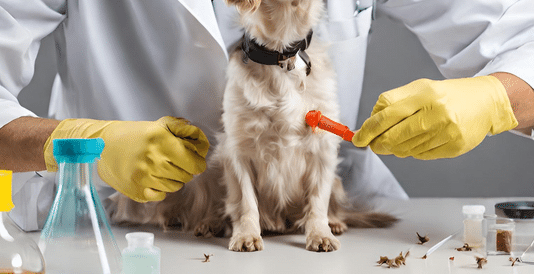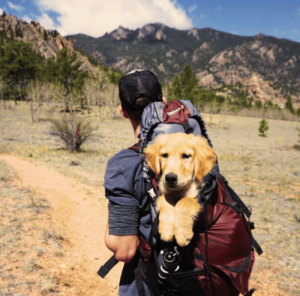Just as you can imagine tiny insects jumping on your body, poking with their sharp mouth, causing little red bumps, and making you scratch all over, the same is true for our furry friends. Many pet owners look for easy ways to keep these pesky bugs away. One popular solution? Flea collars, raise the question: how do flea collars work on dogs?
In this article, we will explore how flea collars protect dogs because Fleas can be a big headache for them, leading to itching and health problems.
We’ll see how they work, the different kinds out there, and why people like them. We aim to help you understand if a flea collar is a good fit for your dog.
Understanding Fleas and their Impact on Dogs
Fleas are tiny bugs that can make dogs very uncomfortable. Dog owners need to know how flea collars work on dogs to help stop the itching and scratching.
Robert Goulding Jr. and his team worked to create solutions to protect pets from fleas. The main purpose of his invention was to find effective methods for flea prevention and control.
Let’s see how these tiny troublemakers affect dogs and why they’re a big worry for pet owners.
The Itchy Stuff:
After biting, your dog becomes super itchy. Dogs start scratching, which leads to reddish skin. These scratches might initially feel good, but they can cause other skin problems, too.
Allergy:
Some dogs have sensitive skin after being bitten by fleas, which causes serious itch. This itching can cause hair loss and inflammation. It is also known as flea allergy dermatitis.
Feeling Weak:
Fleas suck blood from little pups and small dogs. This bloodsucking makes them feel tired. Even this can make them sick.
Spreading Germs:
If your dog unintentionally eats fleas while cleaning itself, it can have a stomach full of worms. Not fun!
Now, you may be wondering what the solution should be if fleas cause a significant danger. The solution is flea collars for dogs. Immediately, you might be curious about how flea collars work.
How Flea Collars Work and What’s Inside Them
Understanding how flea collars work on dogs helps you choose the right one for your pet. Flea collars are shields for our dogs. Keeping those pesky fleas away. Let’s uncover the magic behind these collars.
Superpower Repellent:
Flea collars continuously release special chemicals that fleas don’t like. It’s like a force field around a dog’s neck.
Knockout Punch:
Some flea collars have extra punch inside. These punches are like strong ingredients. This ingredient is like super punches, staying away from the fleas.
Controlled Release:
This is the cool part. These collars use only some of the power at a time. They are like slow-release capsules. In that way, the protection lasts longer.
Strong Chemicals:
There are some common and strong chemicals found in collars. One is called pyrethroids. Another is insect growth regulators (IGRs). These chemicals mess up with fleas.
Cozy Necklace:
Flea collars are comfortable necklaces for our dogs. They are adjustable to fit right. These collars are designed to be cozy so that dogs can wear them without any hassle.
Advantages Vs. Disadvantages of Flea Collars for Dogs
As we know, flea collars are superheroes for our fur family members. Let’s have a look at the pros and cons of flea collars.
The Cool Stuff about Flea Collars
So, Easy:
These collars are so easy. You need to put one around your dog’s neck, and they are good to go.
Long-Lasting:
These collars use only some of their power at a time. It is like slow-release capsules. It is long-lasting, and you don’t need to worry about it daily.
Comfortable Fit:
Flea collars are like cozy necklaces for a dog’s neck. It is comfortably fit and has an adjustable feature. So your dog breathes easily.
Not-So-Cool Stuff about Flea Collars:
Not for Super Allergic Skin:
Some puppies have super allergic skin. As we know, these collars release chemicals, so this chemical is not good for those types of skin. Anywhere you can use following the instructions from the doctor.
Not Instant Action:
These collars take a bit of time to start working. If your dog’s already got fleas. It will only work slowly.
Review of scientific studies and research on the efficacy of flea collars:

Let’s uncover what scientists have found about how flea collars work. Scientists did a lot of experiments with real dogs, fleas, and collars to see what happens.
The Good News:
Many studies show that these collars do a good job of keeping away the pesky fleas. Ingredients used in these collars are superheroes.
Time Factor:
Although flea collars work well, reaching their full power takes a bit of time. So, if your dog already has fleas, don’t worry. It might take some time to work.
Suitable Fit:
The fit matters. Scientists also found that wearing the right type of collar is necessary to work efficiently.
Many studies say flea collars are effective. There are some mixed opinions, too. There are different types of collars. Some work well for one dog, others not. So, choosing the right collar for a dog is very important.
Tips for Using Flea Collars Effectively:
Here are some tips and guidance on using flea collars effectively.
Read the Manual:
When you buy flea collars from a shop, there is a guidebook. You should read the instructions before starting.
Picking the Right Collar:
Flea collars have different types. Some are water-resistant, others aren’t. So, always choose the right collar for your dog. The water-resistant collar won’t lose its power in rain.
Perfect Fit:
Put the collar around your dog’s neck and adjust the fit accordingly. Trim any excess length to avoid discomfort.
Regular Maintenance Checks:
It is very important to check the label to see how long your specific collar remains effective.
Vet Consultation:
When in doubt, consult your vet. They know everything about your furry friend.
Other Ways in the Flea-Fighting Game:
There are some other ways in which you can protect your dogs from pesky fleas.
- Spot-On Treatments: These are like magic drops on your dog’s back. They work fast but do not touch the wet part.
- Oral Medicines: It’s like giving your dog a treat that also fights fleas. Dogs love treats, but some might not like taking these medicines.
Wrap-Up: How Flea Collars Can Help Keep Your Dog Safe from Fleas
Let’s wrap it up and hope you’ve got the answer to the question, ‘Do flea collars work on dogs?‘. Fleas are a bother, but we’ve superheroes in the form of flea collars. These collars work well, but you should use the right ones and consult the vet about the best plan.
It would be best if you understood that every dog has its unique power. So, it is optional that what works well for one will work for another. Knowing your dog, using the right collar for your furry friend, and chatting with your vet is important.





